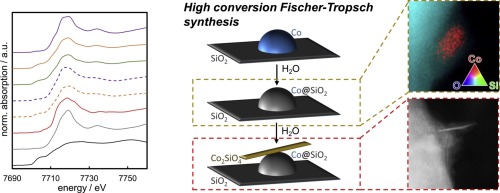Catalysis Today ( IF 5.2 ) Pub Date : 2019-01-30 , DOI: 10.1016/j.cattod.2019.01.065 Moritz Wolf , Emma K. Gibson , Ezra J. Olivier , Jan H. Neethling , C. Richard A. Catlow , Nico Fischer , Michael Claeys

|
Only little is known about the formation and morphology of metal-support compounds (MSCs) in heterogeneous catalysis. This fact can be mostly ascribed to the challenges in directly identifying these phases. In the present study, a series of Co/SiO2 model catalysts with different crystallite sizes was thoroughly characterised with focus on the identification of cobalt silicate, which is the expected metal-support compound for this particular catalyst system. The catalysts were exposed to simulated high conversion Fischer-Tropsch environment, i.e. water-rich conditions in the presence of hydrogen. The transformation of significant amounts of metallic cobalt to a hard-to-reduce phase has been observed. This particular MSC, Co2SiO4, was herein identified as needle- or platelet-type cobalt silicate structures by means of X-ray spectroscopy (XAS) and high-resolution scanning transmission electron microscopy (HRSTEM) in combination with elemental mapping. The metal-support compounds formed on top of fully SiO2-encapsulated nanoparticles, which are hypothesised to represent a prerequisite for the formation of cobalt silicate needles. Both, the encapsulation of cobalt nanoparticles by SiO2 via creeping, as well as the formation of these structures, were seemingly induced by high concentrations of water.
中文翻译:

废Co / SiO 2费-托模型催化剂中金属载体化合物的深入表征
关于多相催化中金属载体化合物(MSCs)的形成和形态知之甚少。这一事实在很大程度上可以归因于直接确定这些阶段所面临的挑战。在本研究中,对具有不同微晶尺寸的一系列Co / SiO 2模型催化剂进行了全面表征,重点是鉴定硅酸钴,这是该特定催化剂体系的预期金属载体化合物。将催化剂暴露于模拟的高转化费-托环境下,即在氢存在下的富水条件下。已经观察到大量的金属钴转化为难以还原的相。这种特殊的MSC,Co 2 SiO 4本文通过X射线光谱法(XAS)和高分辨率扫描透射电子显微镜(HRSTEM)结合元素图谱将其鉴定为针状或血小板型硅酸钴结构。假设在完全被SiO 2包封的纳米颗粒的顶部形成的金属载体化合物代表了形成硅酸钴针的先决条件。似乎是由高浓度的水诱导了SiO 2 通过蠕变对钴纳米颗粒的包封以及这些结构的形成。











































 京公网安备 11010802027423号
京公网安备 11010802027423号